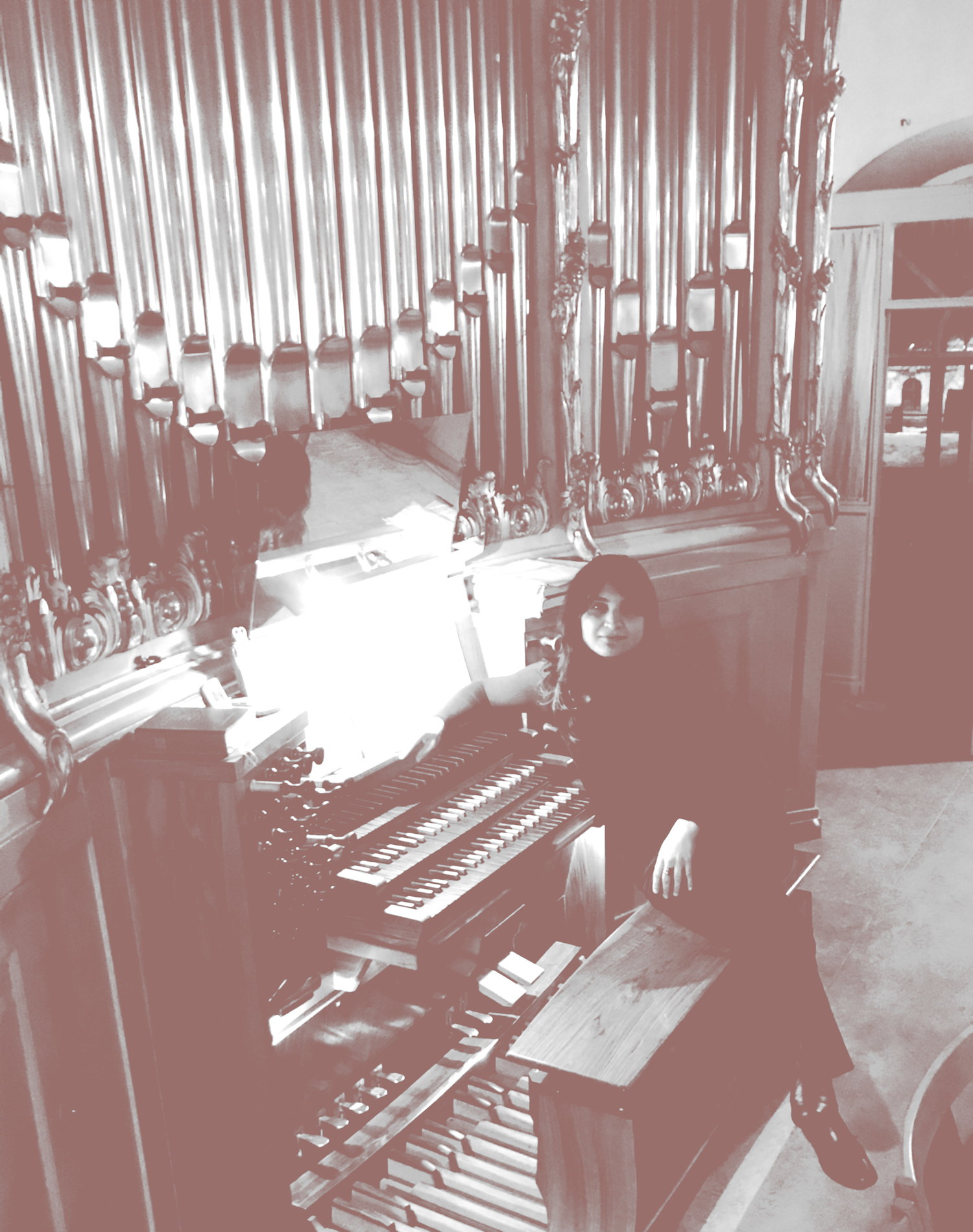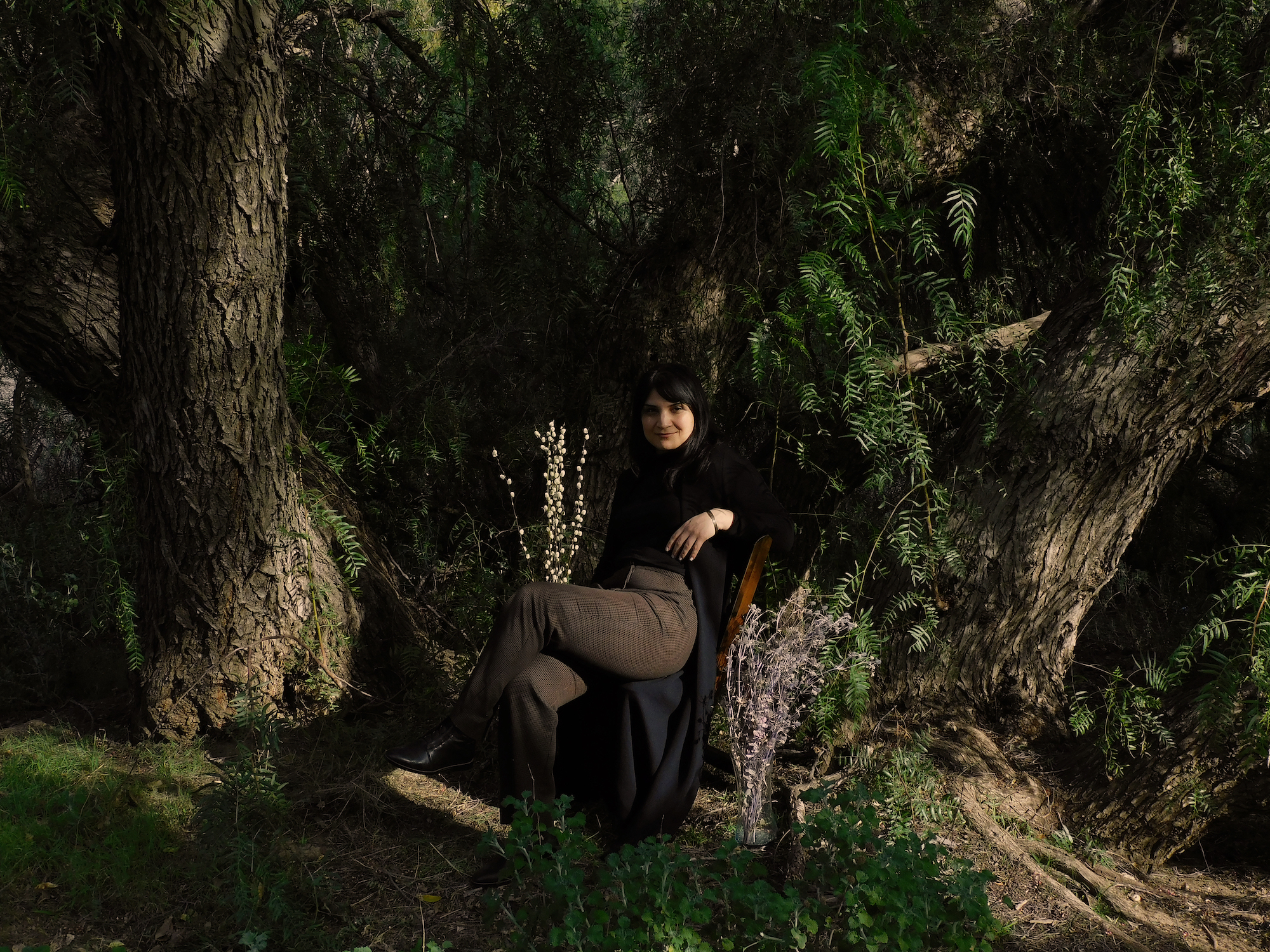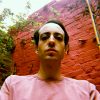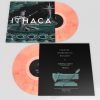Photography SEAN MCCANN
Setting the Records Straight is a new series where we ask our favorite artists to walk us through the most important and meaningful songs in their sprawling back catalogues.
This week’s entry dives straight into the deep listening discography of Sarah Davachi. She’s had quite a year. Aside from launching her own Late Music label, the Calgary-born, LA-based composer has unveiled a string of stellar records, including the live album Figures In Open Air and the doubly essential Cantus, Descant.
Sounds like she’s just getting started too….
“HELIOTROPE”
“TIERGARTEN”
Two favorites among my earlier works, both on the Barons Court LP from 2015. I wrote “Heliotrope” while I was at Mills College, back around March or April of 2012, for a graduate composition seminar that I was taking with Roscoe Mitchell. Most of the students in the class were in the electronic music program but were looking to try our hands at composing for acoustic chamber ensembles, so Roscoe was able to secure for each of us some time with an ensemble that we decided on as a class.
I can’t remember what the original instrumentation was, but I chose to use only viola, flute, and oboe, performed respectively by Clio Tilton, Diane Grubbe, and Kyle Bruckmann, all active performers in the Bay Area. I later added in some cello recordings I had made with a friend and colleague at Mills, Shanna Sordahl.
I was really obsessed with the flute at this time, which is why the instrument gets its own ‘solo’ in this track. I bought a flute during this time, too, and even got a lesson (my first and only) from Maggi Payne in her office one afternoon. The piece is multi-tracked (there are 18 tracks total) and heavily processed, but I’ve always wanted to take the time to arrange and notate it for a larger ensemble or small orchestra to perform live.
I remember recording “Tiergarten” over the course of a few late evenings in my apartment in Vancouver in 2013 with just my Sequential Circuits Pro One synthesizer. I had the lights off and a candle burning; it was simple and nice.
This was probably the first time that I realized I wanted the sound and feel to be really minimal and incredibly quiet as an expression of intimacy, which is a quality that I still strive for in my music.
“NEUSTADT”
This track is on a cassette (Altstadt / Neustadt) that I released in 2015 in a very small quantity as a bonus to Barons Court. I couldn’t remember how I had made this one, and looking back at the session now, I realize I made an error on the cassette credits.
This was sort of an outtake of material that would later end up on the Qualities of Bodies Permanent cassette, and this track in particular was composed using a Buchla Music Easel and a Sequential Circuits Pro One, again probably sometime in around late 2013 or early 2014 while I was living in Vancouver.
Regardless of whether I’m working with electronic or acoustic sound sources, I try to approach things with the same aesthetic and similar intentions, but this is one track of mine that I think sounds especially electronic, distinctly like the synthesizers at hand, and I find myself drawn to its textures a lot lately.
“FEELER”
This track is on the Dominions LP from 2016 and feels to me like an early version of what I enjoy doing harmonically with analog samplers (mainly the Mellotron) these days, which is a kind of modal circularity. It uses an optical disc sampler from 1975 called the Orchestron, which I sampled back in 2012 at the National Music Centre in Calgary, Canada, and then composed with in late 2014.
Once again, we hear the flute. Unlike the Mellotron, which samples acoustic instruments onto a series of magnetic tapes, the Orchestron reads its samples from a photoelectric light source and a clear plastic disc with the physical waveforms represented visually. The space around the waveforms is blacked out, so it works sort of like a photographic negative.
Analog sampling is really interesting to me because the technology behind it – that is, the instrument – is never truly transparent. There are always resultant artifacts that alter the sound even in subtle ways.
A lot of the spectral richness in this track and others that I processed in a similar way — like the piano in “Chanter” from All My Circles Run, which I recorded and then artificially shifted to achieve different pitches – comes from these byproducts of the manipulation itself. I have a strong affection for the sonic character of tape, which is something the Mellotron is known for. The Orchestron was intriguing to me because of its even worse fidelity. I’m not really sure what produces the intense hiss exactly, since it’s more or less the same process that allows sound to be encoded onto film.
This track was also the first that I gave to Paul Clipson to make a film for, so it holds a special place for me for that reason as well. Paul said once that the details in sound help him discover details and narratives in his images, and I find that the reverse is also very much true. Especially in a track like this, in which there are a lot of buried or latent textures, I was able to enter a unique listening experience through his film that I had never encountered before.
“GENTLE SO GENTLE”
This track is on the Vergers LP from 2016, and was composed and recorded in Vancouver in the summer of 2015. The album version was recorded using an EMS Synthi 100 and violin, but I worked out a modified version that I was able to perform live with my EMS Synthi AKS and some cello samples.
The first time I performed it was in August of 2015 when I was opening for Robert Aiki Aubrey Lowe and Ariel Kalma in Vancouver; I tried to do a version with live violin rather than the samples, but I’m pretty crap at playing the violin so it felt really uncomfortable.
I performed it again at Casa del Popolo in Montréal in September of 2015 and at Vooruit in Ghent in November of 2015. I was still figuring out how I wanted my live sets to be during this era and I ended up using my Synthi AKS a lot throughout 2014 and 2015 in part because it was the only electronic instrument I owned at the time that could switch between North American and European voltages.
I also went through a phase where I only wanted to sit cross-legged on the floor when I performed live and this worked well for that. I still like sitting on the floor to perform but I’ve had a few instances where my foot would fall asleep and I wouldn’t be able to stand up and walk off the stage after, so I don’t really do that much anymore.
I really love doing side-long tracks, too; it’s basically the limit you can go with LPs. There are a lot of really subtle intervallic shifts in this track, which is something I am always striving to obtain in anything even vaguely melodic that I do, and I found that performing this live with the KS version of the keyboard (rather than the Cricklewood keyboard I was using on the Synthi 100) was really very well suited for that kind of thing. The KS (keyboard-sequencer) has a flat membrane interface rather than a proper keyboard, very similar to the touch plates that you see on the Buchla 100 model, and it allows you to almost slide across in a really elegant way. The Synthi is not as flexible as Buchla’s design in terms of tuning, but it’s just as unstable so you get all sorts of wonderful fluctuations, especially in a live setting where there are hot spotlights on the instrument when it’s onstage.
I also discovered my love of thirds with this piece, and it’s an interval that I keep returning to whether it’s in the context of equal temperament or meantone temperament. The Synthi is difficult to travel with, but I’d love to be able to perform a longer version of this live one day with a string trio or something like that. Tape echo and tape loops are also a really critical component of my sound, especially in my live setup, and I feel like this is sort of the first piece where I was able to set those two things into place.
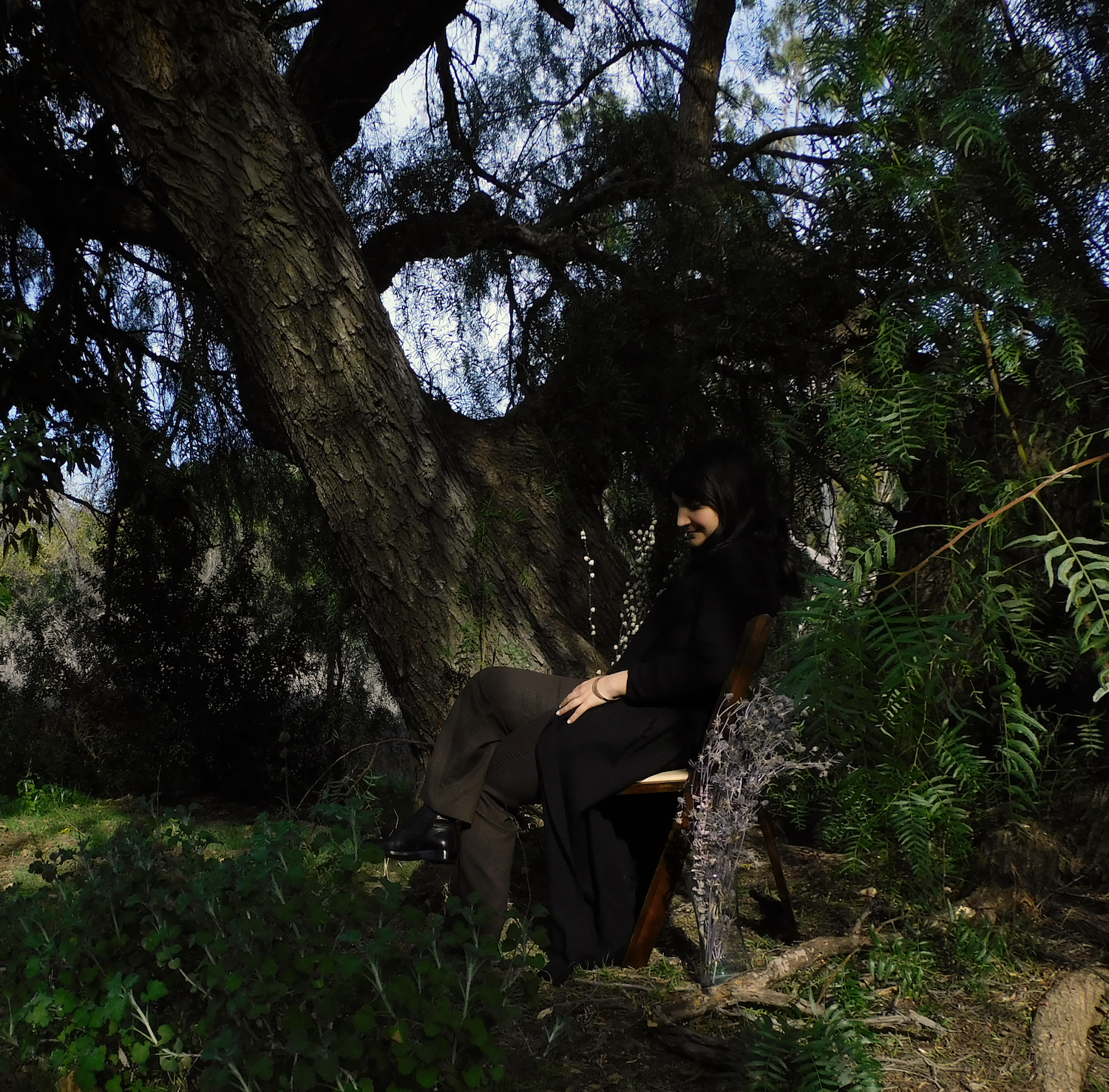
“FOR VOICE”
This track is on All My Circles Run, which finally came out in the spring of 2017 after almost seven months of delays.
This was a special record for me in a few different ways: It was the first time I decided to employ only acoustic sources rather than electronic sources (although “For Organ” was actually created with a Hammond M-3 electromechanical organ, and all of the tracks were processed to varying extents), and it was my first time recording my own music in a proper recording studio, outside of the things I was doing at Mills for school projects.
I spent a weekend in the fall of 2015 at the Hotel2Tango studio in Montréal, with my friend Radwan Ghazi Moumneh engineering, for recording all but this track. It was done at my Vancouver home earlier in the summer of 2015 with a local soprano, Camille Hesketh, who studied at the Royal Conservatory in The Hague and who works a lot both in early music performance and contemporary performance. I remember we spent an afternoon leading up to the recording sitting in a coffee shop in Gastown in Vancouver chatting about vowels and overtones and things like that, so when she came to my house to record I basically just had her sing around 50 different pitches with different vowels, and a few different melodic movements. My apartment at that time was a rectangular concrete loft so there was a lot of beautiful natural reverb added in.
Once I had edited down the recordings, I just started building up the piece pitch by pitch. At its busiest, there are about 15 different tracks creating the harmonies. I also wanted to explore the church modes on this record, which is something I still do a lot of, so each track is a different mode. I learned pretty early on in working with acoustic instruments that I wanted my players to avoid the use of vibrato as much as possible, which is difficult with the voice at higher pitches, but Camille did an amazing job. Vibrato isn’t believed to have been a feature of medieval choral music either, for reasons of intonation and clarity, which is probably why this track especially sounds more austere and reverential.
I’m working on a follow up to this piece that will probably end up on a record with just a soloist, but I’ll actually attempt to make it performable by a choir, which this one isn’t really because of all of the processing.
“MORDENTS”
“HOURS IN THE EVENING”
Let Night Come On Bells End The Day is probably my favorite record of mine. It has a lot of sentimental value and it feels like the first record that has what I think of as a kind of signature sound for me, due to the balance of synthesizer, Mellotron, electric organ, piano, and tape echo, which all feature heavily throughout.
“Mordents” came together really quickly over the course of a few dark and isolated days in January 2017. To me, it feels like a bunch of different elements that just kind of worked well together. There’s also a lot of melodic experimentation there that I hadn’t really done in anything recorded before.
“Hours in the Evening” was the first track I made for the record, which I recorded in the spring of 2016. I had just bought my Korg CX-3 electric organ in January of 2016 and it’s the only instrument you hear on that track. The CX-3 is essentially a combo organ, but it’s meant only to imitate the Hammond B-3 electromechanical organ, so it features drawbars and a built-in Leslie speaker effect. It (and by extension, the Hammond B-3) is one of my all-time favorite instruments and has been at the core of nearly everything I’ve done, either on an album or live, ever since.
The piece actually started as a live set and then I decided to sort of truncate it down to a recorded album version, which I’ve done with a number of older pieces (like “Alms Vert” from The Untuning of the Sky, “Guildford” from Barons Court, “Praha” from Qualities of Bodies Permanent, and “Burgundy” and “A Garden, An Orchard” from Dominions).
I’ve played much longer versions of this piece a number of times, but one nice memory I have of performing it live was when I played it in the parking lot of Hotel2Tango / Constellation Records in Montréal in the summer of 2016. The parking lot is mostly surrounded by tall hedges and trees so it filters out street noise, but I remember as the tape delay was fading out at the end, it mixed in nicely with some birds that were nearby.
The last time I performed this piece live was also the last time that I performed live with Paul Clipson, in Los Angeles in February 2017. It was the same night as the Oscars; my instrument was still in Canada, so I was renting one from a place in Hollywood and I remember as I was picking it up in the afternoon the streets were full of old men in suits walking to the Dolby Theatre. Hours in the Evening was actually the original title of the album before I changed it to Let Night Come On Bells End The Day.
“AUSTER”
I love this track, but I’ve never really been sure why exactly. It was the final piece that I created for the album Gave in Rest, which came out in September of 2018. Earlier in 2020, I was meant to do a residency with the Quator Bozzini, a string quartet based in Montréal, and I was planning on mapping some elements of this piece onto that; hopefully that will happen in 2021.
Harmonically, I’d been thinking about working exclusively with the major second for several years, actually; a double bass player friend at Mills did a piece that had this low ninth that he held for a while and I was completely mesmerized by the interval. In terms of the stops and starts in this piece, I’m not really sure where that idea came from. I was playing a festival in Stockholm in February 2018 and I remember on the flight over I was messing around with some recordings of held tones and there were all these different combinations that I liked and that each sounded so different because of the register, even though they were the same equally-tempered interval, and I figured that I should just cycle through them in this detached way.
I put together a demo of the piece on the flight and was listening to it a lot while I was in Sweden. The instrument in this piece is actually a recorder, performed by my friend Terri Hron, who is based in Montréal. Gave in Rest was a similar process to All My Circles Run — recorded in a sort of mish-mashed way at Hotel2Tango in the summer of 2017, and then edited and processed and put together by me in my home studio.
I was starting to go truly really deep into Medieval and Renaissance music on sort of a theoretical level during this time so I had Terri playing all these decorative melodic passages and in the end I just ended up using the held tones because I was so intrigued by the breathiness of the instrument, effectively like the wooden flue pipes of organs. There’s some processing on the recorder, but most of the textural quality just comes from the intervallic closeness of the pitches and the mixing of the different octaves that are in there.
“IF IT PLEASED ME TO APPEAR TO YOU WRAPPED IN THIS DRAPERY”
This is one of my favorite pieces that I’ve ever written. It took several years and a few different iterations to bring together. The first iteration emerged for a performance at Western Front in Vancouver in November 2016; I was interested in the idea of really subtle microtonal slides and drifts and made a 35-minute piece that had a cello continuously and extremely slowly slide across a few octaves with two synthesizers following it and subtly shifting in and out of relative tune to create a bed of ghost harmonics. Very similar to what happens in the last five minutes of this piece except extended over a much longer duration.
The first part of the piece I explored in “Matins” from Gave in Rest, a piece that was composed in the summer of 2017. The piece that you hear on Pale Bloom actually started as a live set for a concert that I did at the Museum of Jurassic Technology in Los Angeles in October 2017, which was the first thing I worked on when I moved to LA. I enlisted two of my favorite local musicians and performers, Eric KM Clark on violin and Laura Steenberge on viola da gamba, and in that original version I was playing a foot-pumped reed organ as well as the Synthi AKS. I removed the Synthi for subsequent versions because I was interested in the idea of doing a completely acoustic chamber piece that could be performed in a lot of different spaces.
I performed the live piece, which is about 50 minutes long, a few times in Los Angeles with Laura and Eric; for the recording, we all went up to Fantasy Studios in Berkeley in August 2018, which I think was one of the last sessions they did there. We did the recording in a more conventional way, just performing full takes together, straight with no edits or processing, and I mixed the piece in a way that reflected that natural acoustic scenario. That way of recording is pretty unusual for me, and I really enjoyed it.
The title of the piece was taken from a poem by André Breton; the original line in French (“s’il me plaisait de vous apparaître vêtu de cette draperie”) is what’s being sung over and over again by the countertenor (Fausto Dayap Daos) in “Perfumes II.”
I really love performing variations of this piece live. In addition to the performances I’ve done in LA with Laura and Eric, I’ve performed this piece in New York at ISSUE Project Room with Sarah Bernstein and Adam Young; in Berlin at ACUD Macht Neu with Catherine Lamb and Biliana Voutchkova; in Boston at the Metropolitan Waterworks Museum with Ben Swartz and Eden MacAdam-Somer; in Chicago at the Graham Foundation with Whitney Johnson and Phillip Serna; and in London at Café OTO with Galya Bisengalieva, Gregor Riddell, Robert Ames, and the Café OTO choir. I was meant to perform a version of it for pipe organ, choir, and string trio at Otto Wagner Kirche in Vienna in June 2020, as part of Wienerfestwochen, but of course that didn’t happen.
“DIAPHONIA BASILICA”
This is one of my favourite pieces on Cantus, Descant. It emerged through improvisation while I was composing a performance for the pipe organ at Église du Gesù in Montréal in the fall of 2018. It reminds me of elements of “If It Pleased Me…” as well, but in a more textural and somewhat more optimistic way.
When I do live electronic sets, I’m always using a looping pedal to create dense textures that I’m actively building up both harmonically and melodically over time. One thing that I love about pipe organs is that they afford the opportunity to do a similar thing in real time, acoustically, with both hands and both feet engaged.
This is a piece that’s usually possible for me to perform live on larger organs, and is usually how I like to end any set that I do for pipe organ. This particular version was recorded for solo pipe organ on the majestic E. M. Skinner organ at Rockefeller Memorial Chapel in Chicago.
There are a few live recordings of this piece floating around: the original version from Montréal where I was accompanied by Pietro Amato on French horn, Marianne Houle on cello, and Jessica Holmes voice; a version on the Skinner organ in Chicago where I was accompanied by Liz Deitemyer and Matthew Oliphant on French horns; and a recording from the last organ concert I gave before the pandemic, which was for pipe organ and electronics at Janskerk in Utrecht.
The title of the piece refers to a type of polyphony that is very slow moving, creating a strong sense of “basis” in the texture.
